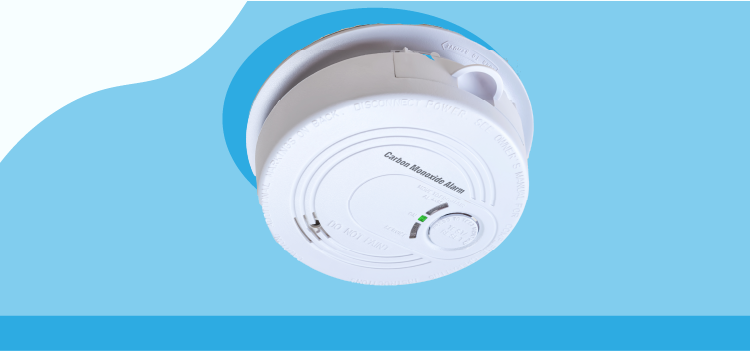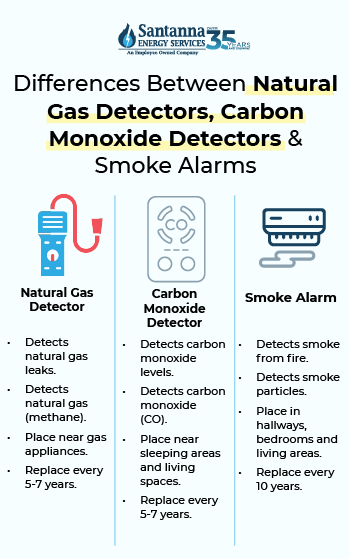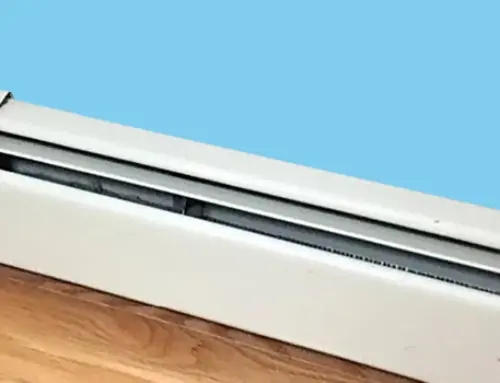Do Carbon Monoxide Detectors Detect Natural Gas?
by Tyler Castle
8 min read

Imagine trusting your toaster to detect a fire—it’s just not equipped for the job. The same logic applies to carbon monoxide detectors when it comes to natural gas leaks. While carbon monoxide and natural gas share similar properties, like being odorless and coming from appliances like stoves, they are vastly different in how they’re detected.
If you have questions about carbon monoxide detectors and if they detect natural gas, you’re in the right place. We’ll clarify the differences and provide practical tips on how to properly safeguard your home from both hazards.
Natural gas vs. carbon monoxide
Knowing the difference between natural gas and carbon monoxide can make all the difference in the safety of your home. Let’s take a look at the differences between natural gas vs. carbon monoxide and why homeowners often confuse them
What is natural gas?
Found deep within the Earth, natural gas is a fossil fuel composed primarily of methane. Natural gas comes from the decomposition of plants and animals from millions of years ago. The gas that’s pressured from the heat exchange over time is natural gas!
Natural gas is used in the home for many everyday functions, including cooking, heating, and powering appliances like clothes dryers, fireplaces, and outdoor grills. One of the most common risks of using natural gas in your home is the risk of natural gas leaks which can lead to explosions or fires if exposed to sparks.
What is carbon monoxide?
The incomplete burning of carbon-based materials creates carbon monoxide, which is a colorless, odorless gas. Think about it this way: every time you start up a gas burner on an oven and you keep the burner clicking before the flame can light, this can cause carbon monoxide. Carbon monoxide can come from gas or oil furnaces, fireplaces, portal generators, and even clothes dryers if their vents are blocked.
This gas can be dangerous because it binds to hemoglobin, preventing oxygen from reaching the body’s cells, and can suffocate you. Prolonged exposure to carbon monoxide can cause poisoning and serious illness.
Key difference: natural gas vs. carbon monoxide
The key difference between these two gases is how each is created. Natural gas is composed of methane (CH₄), a naturally occurring fossil fuel, while carbon monoxide (CO) is a byproduct of incomplete combustion.

Do carbon monoxide detectors detect natural gas?
No, carbon monoxide detectors do not detect natural gas or natural gas leaks.
A carbon monoxide detector is specifically designed to detect carbon monoxide, not natural gas like methane. These detectors sense when CO levels reach dangerous concentrations in the air, which occurs when fuel-burning appliances malfunction or aren’t properly vented.
When a large amount of CO is inhaled, this poisonous gas can be fatal. Carbon monoxide forms from incomplete combustion in appliances like stoves, furnaces, or cars.
Dual carbon monoxide and natural gas detectors, available online from Amazon, are easy to install and can alert you when a gas leak is detected.
Why the confusion? Many people assume that CO detectors cover all gas-related risks, but they don’t. Carbon monoxide and natural gas are two separate threats, requiring separate detectors for proper home safety.
Will a Carbon Monoxide Detector Detect a Propane Leak?
No, a carbon monoxide detector does not detect propane leaks. Like natural gas, propane is a separate gas that requires a dedicated propane gas detector. Propane leaks have a strong, added odor like natural gas (that smells like rotten eggs) to alert homeowners.
However, if propane burns incompletely, it can produce carbon monoxide. In that case, a carbon monoxide detector will detect the carbon monoxide produced but not the propane itself.
Does Propane Produce Carbon Monoxide?
Propane can produce carbon monoxide when it burns incompletely. In this case, when propane secretes carbon monoxide, a carbon monoxide detector will alert you. This happens when appliances using propane, such as stoves and heaters, are not properly ventilated or maintained.
Proper combustion of propane should only produce water and carbon dioxide, but a lack of oxygen can result in dangerous carbon monoxide buildup. Regular inspections of propane appliances help prevent carbon monoxide poisoning.
Do I Need a Carbon Monoxide Detector?
Every home with fuel-burning appliances, fireplaces, or an attached garage should have a carbon monoxide detector. Even all-electric homes can benefit if they have attached garages where car exhaust could lead to carbon monoxide buildup. Keep in mind that some states and municipalities legally require carbon monoxide alarms in residences.
How to Detect Carbon Monoxide
The best way to detect carbon monoxide is by using a carbon monoxide detector placed in key areas of your home. If you don’t have a carbon monoxide detector, physical symptoms of carbon monoxide exposure include dizziness, nausea, headaches, and confusion.
Environmental signs of carbon monoxide in your home include yellow or flickering flames in gas appliances (instead of blue), soot or scorch marks around fuel-burning appliances, excessive condensation on windows near gas appliances, pilot lights frequently going out, and a musty or stale air quality in enclosed spaces.
Does Carbon Monoxide Rise or Sink?
Carbon monoxide is slightly lighter than air but it disperses evenly in a room rather than strictly rising or sinking. Detectors should be placed at eye level or higher, not near the floor like natural gas detectors. Understanding this helps ensure proper carbon monoxide detector placement.
Best smoke and carbon monoxide detectors
If you’re looking to take your home to the next level of protection, check out our list of the best combo smoke and carbon monoxide detectors:
Nest Protect: This awesome piece of tech automatically tests itself to ensure it’s running properly. With dual smoke and CO-detecting capabilities, this alarm features functions where you can “hush” your alarm from your phone without any extra hardware. The Nest Protect also has a voice feature that alerts you of early warnings of fire. This makes Nest Protect one of the best smoke and carbon monoxide detectors.
First Alert Onelink Safe & Sound: With Alexa-enabled capabilities, this model is equipped with a photoelectric smoke and electrochemical carbon monoxide alarm. The First Alert Onelink comes with an easy setup including AC adapter plugs, so you don’t have to rewire your electrical system.
X-Sense SC01: At a modest price of only $39.99 (at the time this article was written), the X-Sense SC01 is one of the best smoke and carbon monoxide detectors. This model comes with a 10-year battery and comes with color-coded LED lights that inform you of your home’s status and notifies you of any danger.
Best natural gas detectors
If you’re in the market to invest in a natural gas detector, here are a few of our favorites:
Kidde Nighthawk NG Detector: The Kidde Nighthawk is one of the best gas and CO detectors with its clear display of the level of carbon monoxide in your home. Even despite power outages, this alarm still works to keep your family safe and sound. According to their website, “the gas sensor is designed to detect natural gas (methane) or propane.”
Amprobe GSD600: This affordable and portable option detects methane and propane gas. The Amprobe quickly identifies and pinpoints where your gas leak is. This meter emits a frequency tone when gas is detected with LED levels that indicate the severity of gas that is present.
DeNova Natural Gas Detector: The DeNova natural gas detector has a 10-year battery. This model is equipped with early warning technology proven to warn you up to 11 minutes faster to provide more time to escape safely.
What is the difference between carbon monoxide and carbon dioxide?
Carbon monoxide (CO) is a deadly gas produced by incomplete combustion, while carbon dioxide (CO₂) is a natural byproduct of breathing and combustion. Carbon monoxide binds to blood cells and prevents oxygen absorption, while carbon dioxide is non-toxic at normal levels but can cause suffocation in enclosed spaces.
FAQs
How long do carbon monoxide detectors last?
Carbon monoxide detectors typically last 5 to 7 years, depending on the model and usage. It’s important to replace them after their expiration date for reliable performance.
Does natural gas produce carbon monoxide?
Yes, natural gas can produce carbon monoxide when it is burned incompletely due to insufficient oxygen or malfunctioning appliances.
Is carbon monoxide a natural gas?
No, carbon monoxide is a colorless, odorless gas produced by the incomplete combustion of carbon-based fuels, while natural gas is primarily composed of methane.
Is natural gas renewable or non-renewable?
Natural gas is considered a non-renewable fossil fuel, as it is formed over millions of years from the remains of ancient organisms and cannot be replenished within a human timeframe.
However, natural gases’ role in the energy landscape is evolving. Natural gas serves as a better alternative to other fossil fuels like coal and oil, producing fewer emissions when burned.
In the end, carbon monoxide detectors are essential, but they cannot detect natural gas. Each detector serves a unique purpose: carbon monoxide detectors alert you to the presence of the dangerous, odorless gas produced by incomplete combustion, while natural gas detectors can detect leaks of natural gas, which has a distinctive added odor for safety. Investing in both carbon monoxide and natural gas detectors can help make your home safer.
Santanna Energy Services is a supplier of Earth-Friendly natural gas and electricity solutions for your home. For over 35 years, Santanna has served customers in Illinois, Indiana, Pennsylvania, Michigan, and Ohio. Our mission is to provide innovative and cost-effective energy solutions that will help our customers achieve their energy goals.
Tyler is an experienced energy professional, having worked for Santanna Energy Services, for the past four years. He is passionate about renewable energy and believes that diversifying the energy grid is the key to a sustainable future. Tyler is dedicated to supplying consumers with the best possible energy solutions and works diligently to make sure that Santanna can deliver the highest quality service.







